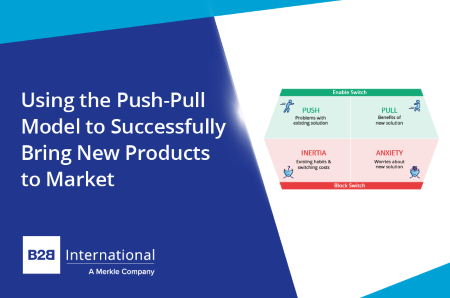
Concept testing is a valuable method for gathering initial reactions to a proposed new product or service – or changes to an existing one – before it progresses too far into development. This helps ensure that course corrections can be made early, aligning the concept with customer and market needs before significant financial investment is made (or before the product is launched).
However, if not done correctly, concept testing can leave you mystified about the true potential of the concept – or even send you in the wrong direction entirely.
This guide outlines key tips and tricks to help ensure your concept test delivers robust insights your organization can trust.
Step 1: The Method
In B2B research, the method is often dictated by the feasibility of reaching the target audience. If the concept is designed for a niche group, a qualitative approach may be necessary to avoid the limitations of a low base size in quantitative measurement. But assuming all else is equal, should you test concepts using a quantitative or qualitative approach? In short, it depends. Consider the following:
-
Depth of feedback required: If you’re seeking a straightforward comparison between a few concepts based on metrics like appeal, relevance, and value for money, a quantitative survey can be a cost- and time-effective way to guide your next steps. However, if you need detailed feedback and want to understand why participants respond a certain way, a qualitative approach is likely more appropriate.
-
Number of concepts to test: If you’re testing more than 2–3 concepts, evaluating them all in depth with the same individuals can be challenging in a 1:1 interview or online survey. Respondents may become confused or lose interest, meaning concepts shown later are not evaluated as thoroughly. To test a larger portfolio, consider using an online platform that drip-feeds information over several days to a limited group – this allows sufficient time and headspace for each concept to be fairly assessed.
-
Complexity of the category: If the concept is technical, it may benefit from clarification and guided understanding. A moderated setting – such as a depth interview or focus group – can help ensure feedback is based on a correct interpretation of what’s being offered.

Step 2: The Stimulus
To ensure feedback from your concept test is robust and trustworthy, the stimulus shown to participants should avoid several common pitfalls:
-
Over-selling the concept: Concepts can sometimes come across as overly ‘sales-y’ or marketing-focused, without enough attention to the objective features and functionality. This can be off-putting and leave participants unclear about what’s actually being offered. It’s acceptable – and recommended – to include intended benefits, but these should be balanced with accurate, objective information about how those benefits will be delivered.
-
Including too much detail: It’s tempting to include lots of information to ensure clarity, but this can overwhelm participants. If you’re working with a research agency, they can advise on the appropriate level of detail based on the method and complexity. A good rule of thumb is to aim for content that can be fully digested in 3–5 minutes, helping maintain engagement.
-
Using inaccurate imagery: Imagery can bring a concept to life, but misleading or overly ambitious visuals can lead to inflated positive feedback. Honest internal conversations early on about how certain you are about the final product’s look and feel are helpful. Imagery can be excluded altogether if needed, or clearly caveated as illustrative and not representative of the final product.
-
Testing unbranded: It’s understandable to be cautious about sharing commercially sensitive ideas, especially if linked to your brand. However, branding can significantly influence how a concept is perceived. A trusted brand can lend credibility to bold claims, while a brand moving into a new space may face skepticism. Testing branded concepts helps uncover these nuances and avoid surprises later. Reputable research agencies will always ensure participants understand the sensitivity of the material and the prohibition of onward sharing.

Step 3: Stakeholder Buy-In & Action Planning
New concepts often represent months of work from multiple stakeholders, leading to high emotional and physical investment. Securing stakeholder buy-in early in the research process is key to ensuring insights are acted upon.
Including a wider group in a project kick-off workshop helps align everyone, address questions or concerns, and incorporate internal knowledge into the questionnaire design. It’s also useful to plan an interactive concept optimization workshop at the end of the project to collectively decide on next steps and assign responsibility for implementation.
B2B International has extensive experience in concept testing across a wide range of industries. If you’d like to explore how we can support you in understanding the potential of a new product or service, please get in touch.
Readers of this article also viewed:
Using the Kano Classification Model to Quantify the Importance of Product Features and Attributes 3 Use Cases for Kotler’s Five Product Levels Framework in B2B Research B2B Insights Podcast #64: The Best Frameworks to Develop Winning Propositions Using the Push-Pull Model to Successfully Bring New Products to Market
To discuss how our tailored insights programs can help solve your specific business challenges, get in touch and one of the team will be happy to help.

